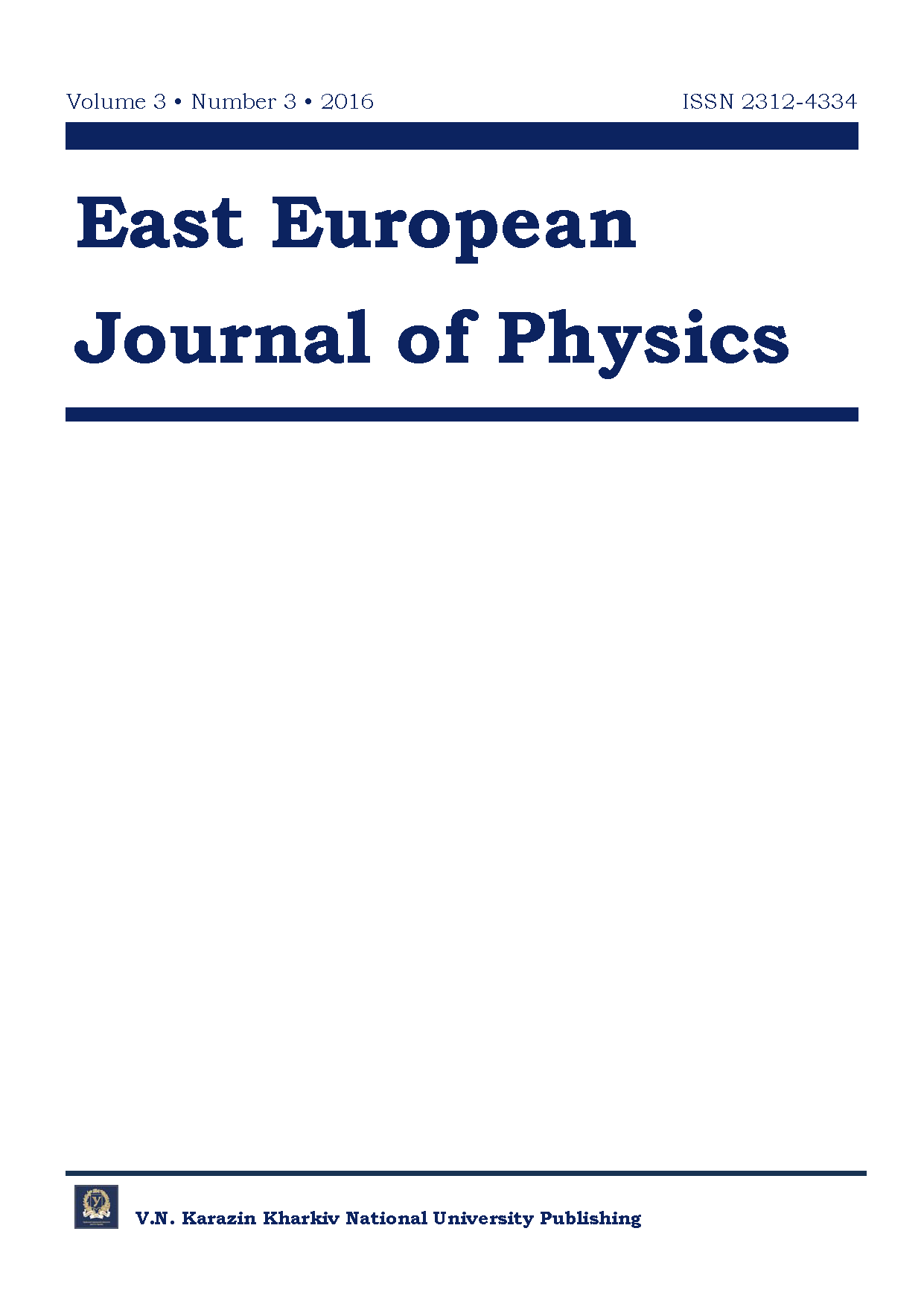Thermal and Epithermal Neutron Generation for Nuclear Medicine Using Electron Linear Accelerator
Abstract
In this paper, to obtain streams of thermal and epithermal neutrons are used delayed neutrons emitted from the target with a fissile material. The target preliminarily activated with help of electron beam from linear accelerator with an energy of 20 MeV and a power of 9 Watts. At the same time to obtain a stream of thermal as well as epithermal neutron density 6 10^-5 n / (cm^2 s) The results of experiment are presented where half-decay curves have been measured of emitting delayed neutrons radioactive nuclei produced in the fission process. It has been shown that the activated target, which contains the fissile material, presents a compact small size source of delayed neutrons. It can be delivered to the formator where thermal and epithermal neutrons are formed during a certain time period with help of the moderator, absorber and collimator. Then this target is moved to the activator being replaced with another target. Thus, pulsed neutron flux is produced. The duration of neutron pulse corresponds to the presence time of the activated target in the formator, and time interval between pulses is determined by the delivery time of the target from the activator to the formator. Given that the yield of neutrons from the target is directly proportional to the power of the beam of accelerated electrons, shows that the beam power of 1.5 - 3 kW, the flux density of thermal and epithermal neutrons can reach the values of (2-3) 10^9 n / (cm^2 s). Such a neutron beam can be used in nuclear medicine, in particular, in neutron capture therapy of oncologic diseases.
Downloads
References
Dovbnja A.N., Kuplennikov Je.L., Kandybej S.S., Krasil'nikov V.V. Nejtrony protiv raka [Neutrons against cancer] / JeChAJa. Fizika jelementarnyh chastic i atomnogo jadra. – 2014. – T.45. – No. 5-6. – P.1751 – 1786. (In Russian)
Locher G.L. Biological Effects and Therapeutic Possibilities of Neutrons // Am. J. Roentgenology. Vol.36. P. 1-13.
Rolf F. et.al. Boron Neutron Therapy of Cancer. Current Status and Future Prospects // Clin. Cancer Res. 2005. Vol.11(11). P. 3987-4002.
Zaycev K.N. Portnov A.A. i dr./ Nejtronozahvatnaya terapiya teplovymi nejtronami na IRT MIFI [BNCT thermal neutrons at the IRT MEPhI] /Atomnaya ehnergiya, t.91, vyp. 4, oktyabr' 2001. (In Russian)
Hatanaka H., Nakagava Y. Clinical Results of Long-Surviving Brain Tumor Patients Who Underwent Boron Neutron Therapy // Intern. J. Rad. Oncol. Biol. Phys. – 1994. - Vol. 28. – P.1061-1066.
Mishima Y. Selective Thermal Neutron Capture Therapy of Cancer Cells Using Their Specific Metabolic Activities Melanomas Prototype // Cancer Neutron-Capture Therapy. N.Y.: Plenum Press, 1996. P. 1-26.
Gueulette J. et al. Specification of Radiation Quality in Fast Neutron Therapy; Microdosimetric and Radiobiological Approach in Fast Neutrons and High-LET Particles in Cancer Therapy / Eds.: R. Engenhart-Cabillic and Wambersice. I(st Ed. Berlin; Ytidelberg; Spinger-Verlag, 1998. – Vol. 150. – P. 31-53.
Harling O.K. et. Al. The MIT User Center for Neutron Capture Therapy Research // Rad. Res. - 2005. – Vol. 164. – P. 221-229.
Reley K.J. et. Al. The International Dosimetry Exchange for BNCT: A Basis for Poling and Collectively Analyzing Clinical
Results // 12 Congress BNCT, Japan, 2006.]
Borisov G.I. Teoreticheskie i jeksperimental'nye fizicheskie metody nejtronnoj terapii [Theoretical and experimental physical methods of neutron therapy] // JeChAJa. – 2011. – Vol. 42. – No. 5. P. 1371-1479. (In Russian)
Taskaev S.Ju. Uskoritel'naja koncepcija nejtronozahvatnoj terapii.1. Uskoriteli (obzor). Preprint IJaF 2011-15. Novosibirsk, 2011. p.19.
Ajzackij N.I., Borc B.V., Vodin A.N., Demchenko P.A., Zelinskij A.Ju., Karnauhov I.M. i dr. // Istochnik nejtronov NNC HFTI [Neutron Source KIPT] // VANT. – 2012. – No.3(79). – P.3-9. (In Russian)
Kasilov V.I., Gokov S.P., Dovbnja A.N. i dr. «O vozmozhnosti ispol'zovanija zapazdyvajushhih nejtronov delenija v formirovanii puchkov dlja jadernoj mediciny» [On the possibility of using delayed neutron fission in forming beams for nuclear medicine] / Tezisy ҲҲIII mezhdunarodnogo seminara po uskoriteljam zarjazhennyh chastic. 08-14 sentjabrja 2013 g. Alushta, Krym. (In Russian)
Piksajkin V.M., Kazakov L.E., Korolev G.G., Isaev S.G., Roshchenko V.A., Tarasko M.Z. Otnositel'nyj vyhod i period otdel'nyh grupp zapazdyvayushchih nejtronov pri delenii 235U , 238U ,239 Pu ehpiteplovymi nejtronami [The relative yield and between individual groups of delayed neutrons in the fission of 235U , 238U ,239 Pu by epithermal neutron] // Atomnaya ehnergiya. – 2000. – Vol.92. – No.2 – P.135-143. (In Russian)
Homich A.A., Kasilov V.I., Kirichenko V.V. i dr. Model' vyhoda zapazdyvayushchih nejtronov deleniya v ehksperimente na impul'snom linejnom uskoritele elektronov [Model of delayed fission neutrons in experiments on pulsed electron linear accelerator] // Visnyk Harkivs'kogo universitetu. – 2006. – No. 732. – P.87-95. (In Russian)
Authors who publish with this journal agree to the following terms:
- Authors retain copyright and grant the journal right of first publication with the work simultaneously licensed under a Creative Commons Attribution License that allows others to share the work with an acknowledgment of the work's authorship and initial publication in this journal.
- Authors are able to enter into separate, additional contractual arrangements for the non-exclusive distribution of the journal's published version of the work (e.g., post it to an institutional repository or publish it in a book), with an acknowledgment of its initial publication in this journal.
- Authors are permitted and encouraged to post their work online (e.g., in institutional repositories or on their website) prior to and during the submission process, as it can lead to productive exchanges, as well as earlier and greater citation of published work (See The Effect of Open Access).








